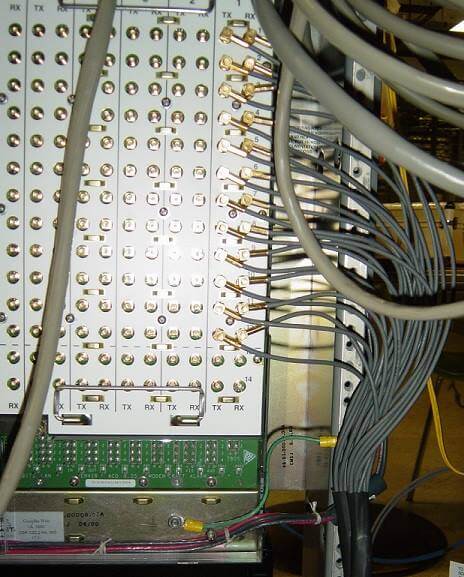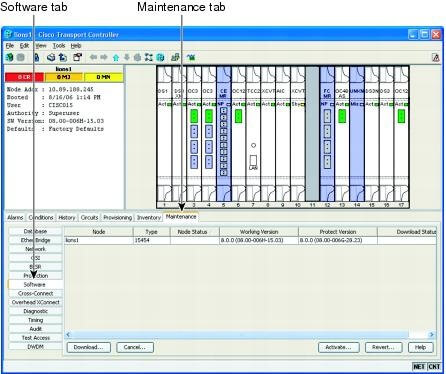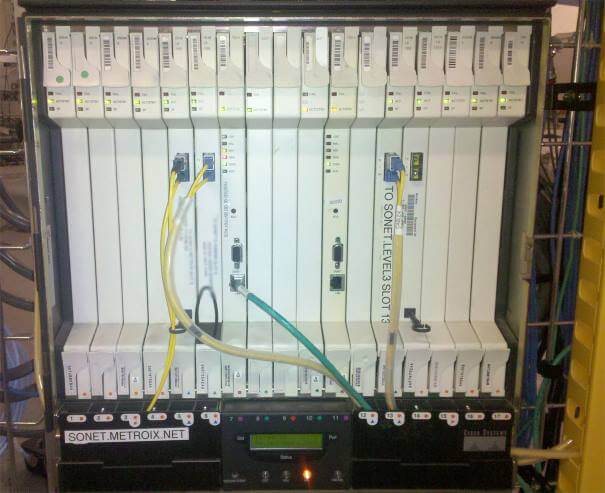This is a class 4/5 telephone switch which establishes calls via SS7 links connecting with AT&T and deliver's the audio through channelized T1 and multi channelized T3 phone trunks. One T1 can handle 23 phone lines.
Part of my upgrade process when I first started on this project was to re-establish new SS7 link with a new carrier. Then, I was to upgrade all of our individual T1 trunks to a T3, so we could more easily increase/manage our phone traffic. This also allowed for easier transport of phone traffic from a designated central office, over our sonet, and into our phone switch. With this upgrade there was no longer the need to have to cross-connect a bunch of individual T1's, then bring those to a Mux, and over the sonet. Doing it the old way required additional equipment and was more difficult to manage. The old way was also more costly to the business.

This is the back of our primary sonet box in METROIX. Here you can see all of the SMB T3 connectors coming off, and they then are cross-connected directly into our Metaswitch phone switch.
In running a phone switch you had to be able to keep your head clear when emergencies came up. If there was a multiple tickets opened for one-way audio or dropped calls, then you had to be able to find the coorelation between your call traces and be able to rule out individual T1's. AKA, look for a pattern and trust yourself in your knowledge. Sometimes when you have outages, you could have 3-4 people calling your or at your desk. Even sometimes the CEO could be asking you what is going on. So, best to not let your nerves get the best of you.
Part of the services we offered from this phone switch was traditional POTS lines (Plain old telephone service)- class 4, as well as SIP- class 5. That is what makes this switch so special. Well, not to mention that it was the second switch ever producted for this model. Part of running this expensive peice of equipment was having training in translations as well as knowing telecom wiring and troubleshooting. We delivered our SIP service to IAD's (Integrated Access Devices) as over DSL, T1, T3, or even fiber. An IAD is a device that speaks SIP back to the phone switch and then is able to convert that messaging to a normal analog connection. This allows customer's to plug their PBX's (telephone systems) directly into our equipment. Delivering over SIP is a huge cut in costs and allows you to place a dial tone virtually anywhere. Heck, at one point we were even providing telephone service into digital billboards.
Working with a class 4/5 phone switch was a lot of fun. I would consider doing it again in the future. It is definitly a niche area of IT that we all highly rely on. Maybe the newer models of Metaswitch offer mobile connectivty in some form of a integrated solution.


Lastly, part of configuring redundancy was a project where we upgraded our Cisco Sonet management cards, TCC cards to TCC+ cards, and create redundant T3 routes for our phone trunks. This way if we lost part of our fiber backbone, then we would have another path with equal bandwidth going back to our datacenter. This ensures our phone trunks would never be down and we had sonet redundancy from a timing and management stand point.
"A TCC+ card performs system initialization, provisioning, alarm reporting, maintenance, diagnostics, IP address detection/resolution, SONET DCC termination, and system fault detection.
The TCC+ card incorporates system timing source selection and a highly stable, stratum 3, internal timing reference. Nonvolatile database storage for communication, provisioning, and system control is provided on the TCC+ card, allowing complete removal of system power with full database recovery and survivability."
http://www.cisco.com/c/en/us/products/interfaces-modules/ons-15454-timing-communications-control-plus-tcc-card/index.html

